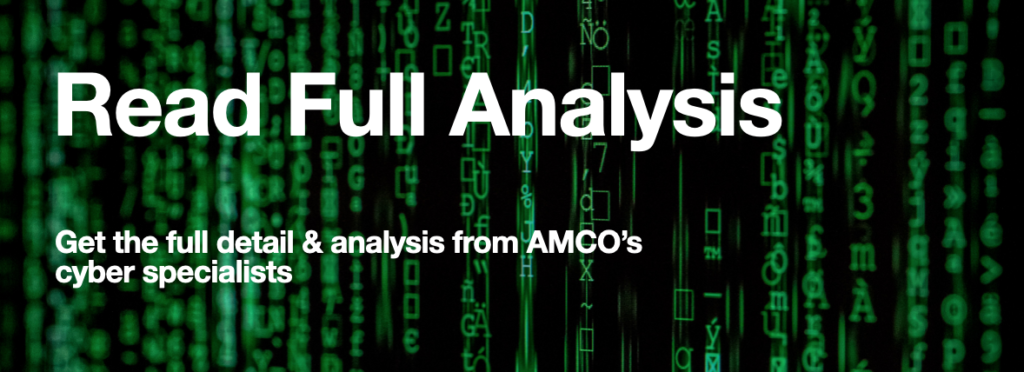
60 second summary
The quick answer is two-fold: 1) From a technology perspective it is pretty difficult to hack into a bank account 2) From a human error / vulnerability perspective there are lots of potential vulnerabilities.
Typical ways to hack a bank account include:
- Phishing attacks: tricking a user into sharing passwords / giving access
- Malware: downloading malware – malicious software
- Fake banking Trojan: downloading fake banking apps
- Share credentials (via 3rd party hacks): having your password shared illegally online
- Public Wifi manipulation: someone hacking your computer when you’re logged onto a public wifi network (which are notoriously insecure)
AMCO’s Quick Security Tips
The four easiest things you can do to stop hackers getting into your bank account are:
- Strong passwords: set-up strong unique passwords
- Phishing aware: keep vigilant for any phishing attempts
- Public Wifi: don’t use it! Or if you do – us it sparingly
- Device security: ensure you have up to date software on your devices, including anti-virus software
Learn more & get details
To learn more about this subject, read our team’s full analysis below . . .

Typical Methods Hackers Employ to get into bank accounts
Phishing Attacks
Phishing remains one of the most effective ways for hackers to steal private data. They create fake emails, texts, and webpages that appear to be from trusted companies or banks, urging users to take immediate actions like changing passwords or confirming account details. Once the user provides their credentials, the hacker gains access.
Hackers have adapted by targeting trusted entities such as real estate agents or solicitors, exploiting established trust to steal money. The difficulty in spotting such fraud—often with personalised details and seemingly legitimate email addresses—makes this method especially dangerous.
Malware and Keylogger
Malware is software that damages devices, often entering unknowingly when users open infected files or click on malicious links. Keyloggers, a type of malware, record every keystroke, capturing sensitive data like login credentials.
This may seem harmless, but if you type your email, password, and bank URL, the hacker gains everything needed to access your account.
Fake Banking app Trojan
The mobile banking Trojan is a deceptive cyber-attack. It’s a separate app containing a Trojan that targets banking apps on your phone once installed.
When the Trojan detects a banking app, it displays a fake login screen that looks identical to the real one. If the user enters their details, the hacker gains access to the information.
Credentials on unsecured platforms
As digital shopping grows, so does our vulnerability, especially when using digital banking. Many websites lack strong security, making them easy targets for hackers. Since most people reuse passwords for convenience, hackers can access valuable login credentials by breaching a vulnerable platform.
Public Wifi Manipulation/Man in the middle attack
Public Wi-Fi networks are highly insecure, making them prime targets for hackers. Cybercriminals can perform man-in-the-middle attacks to intercept sensitive data, such as login credentials, as it’s transmitted. Additionally, hackers may use DNS cache poisoning to redirect you to fake sites that resemble real ones, tricking you into revealing your personal information.
Mobile Exploits and SIM Flipping
SIM swapping is a dangerous technique where cybercriminals impersonate you to convince your mobile provider to transfer your phone number to a new SIM. Once successful, they can bypass SMS verification codes by receiving them on their own SIM card. This allows them to access your accounts and steal funds without your knowledge.
The main reasons bank accounts are at risk
Human Error
The human element is still cybersecurity’s weakest point. User errors, such as repeating passwords or falling for phishing schemes, these factors frequently give hackers easy access.
Insufficient Knowledge
Many people do not identify alert signs and are ignorant of contemporary hacking strategies. They are vulnerable to even simple assaults since they have not received enough cybersecurity instruction.
Obsolete Software and Technologies
Although most banks rely on new cybersecurity methods by using AI detection models, unfortunately some banks still use outdated cyber security measures. Sophisticated hackers may be able to take advantage of weaknesses in banks that depend on outdated technology. In a similar vein, people expose oneself to attack when they neglect to update their software or gadgets.
How to Keep Your Bank Account and Yourself Safe
1. Make Your Passwords Stronger
· For your bank account, create distinct, complicated passwords using a combination of unique symbols, numbers, and letters.
· Avoid using the same password for multiple platforms, as not every platform has advanced cybersecurity measures.
· Try to use software such as Dashlane, Lastpass, Bitwarden etc, as they would let you create strong passwords.
2. Watch Out for Phishing Attempts
· Never click on dubious links and always verify the sender’s email address. You can double check the sender email address by hovering over the sender’s name. Fake email frequently makes use of strange characters or lookalike domains, such as b@nkname.abc or support@bankname-security.com.
· Look out for any grammatical errors as most of the prominent companies and senders proofread their emails.
· Keep in mind that trustworthy banks will never SMS or email you for critical information.
· You can use tools like PhishTank, Spamtitan, etc to sniff out any phishing links or emails.
3. Steer clear of public Wifi
· Never carry out any private tasks on an unprotected or public network. Use someplace safer, like your home Wi-Fi.
· If you wish to do private tasks over a public Wi-Fi network, make sure to use a VPN. Before your device transmits your data over the network, a VPN provider encrypts it. All that will be visible to anyone watching your connection are unintelligible encrypted packets.
4. Make sure that your devices are secure
· Install and maintain antivirus software.
· To eliminate vulnerabilities which could give cyber criminals access to your system, make sure the operating system and apps on the device that you use are updated on a regular basis.
· You can use strong Antivirus such as Norton360, Avestaone etc.

AMCO’s Recommendations
The general summary is that it’s difficult to technically hack a bank account (i.e. for a hackers to actually ‘break into’ an online bank account, but that it is is relatively easy for hackers (or fraudsters) to use ‘confidence tricks’ of various sorts to trick their way into your bank account.
Our top tips to prevent this from happening are as follows:
- Strong passwords: set-up strong unique passwords
- Phishing aware: keep vigilant for any phishing attempts
- Public Wifi: don’t use it! Or if you do – us it sparingly
- Device security: ensure you have up to date software on your devices, including anti-virus software




Leave a Reply